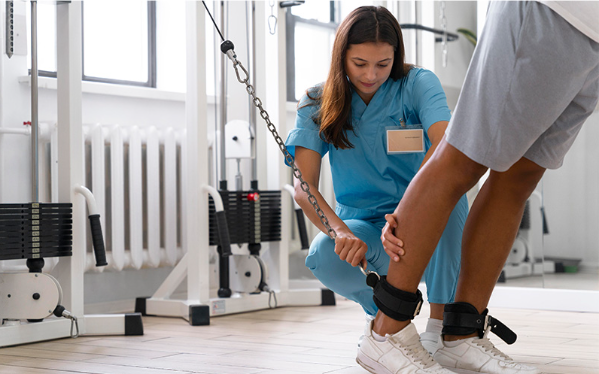Rehabilitation requires strategy, structure, and clinical insight. In Singapore, the work of a rehab physiotherapist extends beyond injury care into the realm of long-term physical resilience. These professionals use a mix of evidence-based methods and technology to restore function and prevent recurrence. In the context of physiotherapy in Singapore, rehab practitioners operate with clear goals: reduce pain, rebuild control, and help clients move confidently again. Their approach is defined by technical expertise, continuous assessment, and an understanding of individual recovery challenges.
Manual Therapy Techniques That Restore Motion
Rehab physiotherapists use manual therapy with their hands to mobilise joints, reduce muscle tension, and promote better alignment. This technique improves circulation and helps loosen restrictions that limit mobility. In Singapore’s clinics, joint mobilisation and soft tissue release are applied with precision to specific structures affected by injury. These methods are especially effective in the early stages of rehabilitation, where stiffness, inflammation, or scar tissue may interfere with progress. Manual therapy also prepares the body for more active phases of recovery.
Movement Re-Education Through Guided Exercise
Beyond relieving immediate discomfort, rehab physiotherapists focus on movement re-education. Injuries disrupt natural patterns and may cause the body to rely on compensations. These may lead to imbalances. Physiotherapists guide clients through structured exercises that retrain posture, coordination, and joint control. In physiotherapy clinics across Singapore, movement drills are carefully selected to replicate real-life tasks and build a foundation for daily function. These sessions are progressive, gradually increasing in complexity and intensity to meet recovery goals.
Equipment That Enhances Recovery Outcomes
Tools play a key role in rehab settings. Physiotherapy clinics are equipped with devices designed to accelerate progress. Resistance bands, balance boards, foam rollers, and therapy balls are widely used to target muscle control and stability. Advanced equipment such as biofeedback machines or isokinetic testing devices allows therapists to monitor progress in real-time. Rehab physiotherapists in Singapore integrate these tools strategically, ensuring that each session provides measurable benefits. The use of such aids improves accuracy and keeps rehabilitation goals on track.
Tapping into Neuromuscular Re-Education
Rehabilitation is not limited to muscular strength. The nervous system must also be retrained after trauma or surgery. Neuromuscular re-education is a technique that focuses on improving the connection between the brain and the body. This method involves repetitive, controlled movements that rebuild coordination and reaction time. Rehab physiotherapists use these techniques, particularly with post-operative patients, stroke survivors, or individuals recovering from nerve damage. In physiotherapy clinics in Singapore, this form of therapy is instrumental in restoring confidence in movement and preventing falls or re-injury.
Adapting Interventions for Specific Populations
One of the strengths of a rehab physiotherapist is their ability to tailor techniques to the needs of different populations. Recovery pathways vary widely between young athletes, older adults, and patients with chronic illness. Whether it’s modifying exercises for joint replacements or introducing low-impact routines for clients with cardiovascular concerns, adaptability is critical. In Singapore, physiotherapy providers maintain a high standard of care across all patient groups by adjusting tools, pacing, and objectives to match the context of the client’s life and health condition.
Learn More: Improve Your Posture For a Healthier Body And Mind
Celebrating Triumphs Through Measured Progress
Recovery is rarely a straight line, but physiotherapists celebrate small wins that mark improvement. Measuring gains in flexibility, endurance, and pain reduction helps both therapist and client stay motivated. Rehab physiotherapists document these changes meticulously and use them to inform the next stage of treatment. In Singapore, where many clients return to high-functioning roles in sport, work, or community, these triumphs are essential indicators of readiness. The focus remains not only on healing but also on regaining strength, balance, and long-term confidence.
Building Knowledge Through Education
Education is central to every rehab session. Physiotherapists teach clients how to protect healing tissues, manage daily activity, and prevent further injury. They explain proper movement mechanics and offer practical strategies for home and work. This guidance reduces dependency and increases accountability. Singapore’s rehab physiotherapists see knowledge transfer as part of the recovery process, allowing individuals to take charge of their movement and manage their well-being far beyond the clinical setting.
A Dynamic Approach to Recovery
Rehab physiotherapists in Singapore operate at the intersection of science and real-world function, using tools and techniques that respond to the changing needs of each client. From hands-on therapy to advanced equipment and movement retraining, they guide recovery with structure and intent. Their efforts turn setbacks into strength and create sustainable progress through every phase of healing.
For more information about physiotherapy services, contact Rehab & Beyond today.

